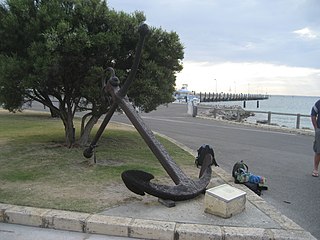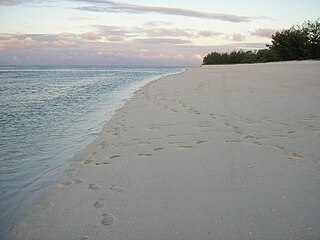
A shipwreck is the wreckage of a ship that is located either beached on land or sunken to the bottom of a body of water. Shipwrecking may be intentional or unintentional. There were approximately three million shipwrecks worldwide as of January 1999, according to Angela Croome, a science writer and author who specialized in the history of underwater archaeology.
Over 1400 ships have been wrecked on the coast of Western Australia. This relatively large number of shipwrecks is due to a number of factors, including:

City of York was a 1,167 GRT iron ship which sank after hitting a reef off Rottnest Island in the last few kilometres of its voyage from San Francisco to Fremantle, Western Australia in 1899.

Since the first Europeans visited the west coast of Australia in the 17th century, Rottnest Island has seen numerous shipwrecks. The 11-kilometre-long (6.8 mi) and 4.5-kilometre-wide (2.8 mi) island is surrounded by hidden and partly exposed reefs whilst being buffeted by north-westerly winter gales as well as very strong south-west summer sea "breezes". It is situated 12 kilometres (7.5 mi) west of the port of Fremantle meaning that much of the maritime traffic to Western Australia's major port passes close by.

RMS Quetta was an iron-hulled steamship that was built in Scotland in 1881 and wrecked with great loss of life in the Torres Strait in 1890. She was operated by British India Associated Steamers (BIAS), which was controlled by the British India Steam Navigation Company (BISN). She was wrecked on a previously unknown rock, which has been called Quetta Rock ever since. The Underwater Cultural Heritage Act 2018 protects the wreck.

Loch Vennachar was an iron-hulled, three-masted clipper ship that was built in Scotland in 1875 and lost with all hands off the coast of South Australia in 1905. She spent her entire career with the Glasgow Shipping Company, trading between Britain and Australia. The company was familiarly called the "Loch Line", as all of its ships were named after Scottish lochs. The ship was named after Loch Venachar, in what was then Perthshire.

Fremantle Harbour is Western Australia's largest and busiest general cargo port and an important historical site. The inner harbour handles a large volume of sea containers, vehicle imports and livestock exports, cruise shipping and naval visits, and operates 24 hours a day. It is located adjacent to the city of Fremantle, in the Perth metropolitan region.

Lady Elizabeth is a wrecked iron barque of 1,155 tons built by Robert Thompson Jr. of Southwick, Sunderland and launched on 4 June 1879. Robert Thompson Jr. was one of the sons of Robert Thompson Sr. who owned and operated the family ran shipyard J. L. Thompson & Sons. Thompson Jr. eventually left the family business in 1854 to start his own shipbuilding business in Southwick, Sunderland. The ship was built for John Wilson as a replacement for the 658-ton, 1869-built barque Lady Elizabeth which sank off Rottnest Island, Western Australia in 1878.

Masthead Island is a coral cay located in the southern Great Barrier Reef, 60 kilometres northeast of Gladstone, Queensland. The island is a protected area and forms part of Capricornia Cays National Park. Masthead Island is one of the most undisturbed cays in the national park because human and feral animal impacts have been rare. The cay covers an area of 0.45 square kilometres (0.17 sq mi) and is surrounded by a coral reef that is partially exposed at low-tide. It is part of the Capricornia Cays Important Bird Area.
Sun was a brig built in 1819 at Sunderland and was condemned at the Cape of Good Hope in August 1822. She was repaired and began sailing east of the Cape. She was wrecked in May 1826 in the Torres Strait.

Geffrard was a 321-tons-burden British brig that traded between Australia, Mauritius, and Shanghai, and was wrecked off the coast of Western Australia on 13 June 1875. She was built in 1853 by Fred Clark in Jersey in the Channel Islands. By 1873 she had made her way to Melbourne and was owned by Fred Davis and under the control of Captain William James Munday. Her movements after that were generally around the southern coasts of Australia, from Geraldton in the west to Sydney in the east, laden with a variety of general cargo.
Anthony Curtis was an Australian whaler and businessperson. Owner of many ships, Curtis sent the Fanny, which weighed between 25 and 36 tonnes, to Java, Indonesia, in December 1834, and also purchased the Lady Sterling in the same year.

SS Kwinana was an Australian ocean-going cargo and passenger steamship. She was built in England in 1892 as the cargo ship SS Darius. In 1912 she changed owners, was refitted as a cargo and passenger ship and renamed Kwinana.

SS Arratoon Apcar was an iron-hulled sail and steam merchant ship that was built in Scotland in 1861 and wrecked off the coast of Florida in 1878. Her wreck in shallow water on Fowey Rocks is now a scuba diving site.

RMS Orizaba was a Royal Mail Ship wrecked off Rockingham, Western Australia on 16 February 1905. On her approach to Fremantle, a smog of bushfire smoke was obscuring the coast and the captain lost his bearings. The ship went aground in 6.1 metres (20 ft) of water on Five Fathom Bank, west of Garden Island.
Caledonia was a merchant ship built in British India in 1829. She traded between India, China, Mauritius, and the Australian Colonies. She played an important role in the development of King George Sound. She made two voyages transporting convicts, one voyage from Madras and the other from Swan River Colony, both to Sydney, Australia. After her sale in 1840 her registry shifted to London and she became a general trader. She was last listed in 1855.
Rockingham was launched at Sunderland in 1818 and immediately became an East Indiaman, sailing under a license from the British East India Company (EIC). She made one voyage for the EIC. She was wrecked in 1830 while delivering immigrants to Western Australia.

Graeme Henderson is an Australian maritime historian and maritime archaeologist. Since the early 1970s he played a leading role in developing maritime archaeology and maritime museums in Australia, having assisted in, or led the investigation of wrecks in the Fremantle area as well as on the Western Australian coast, on islands offshore and in the Eastern States. Henderson was the first Director of the new Western Australian Maritime Museum on Victoria Quay from 1992 to 2005.
Cumberland was built in India in 1827, probably at Cochin but possibly at Surat. She sailed to Great Britain and assumed British registration. She traded between England and India under a license from the British East India Company (EIC). She wrecked in March 1830 near Cape Leeuwin coming from Sydney on her way to Bombay.

Nor 6 was a prawn trawler that sank on 25 April 1963 after a collision with the Zuytdorp Cliffs off the coast of Western Australia.















